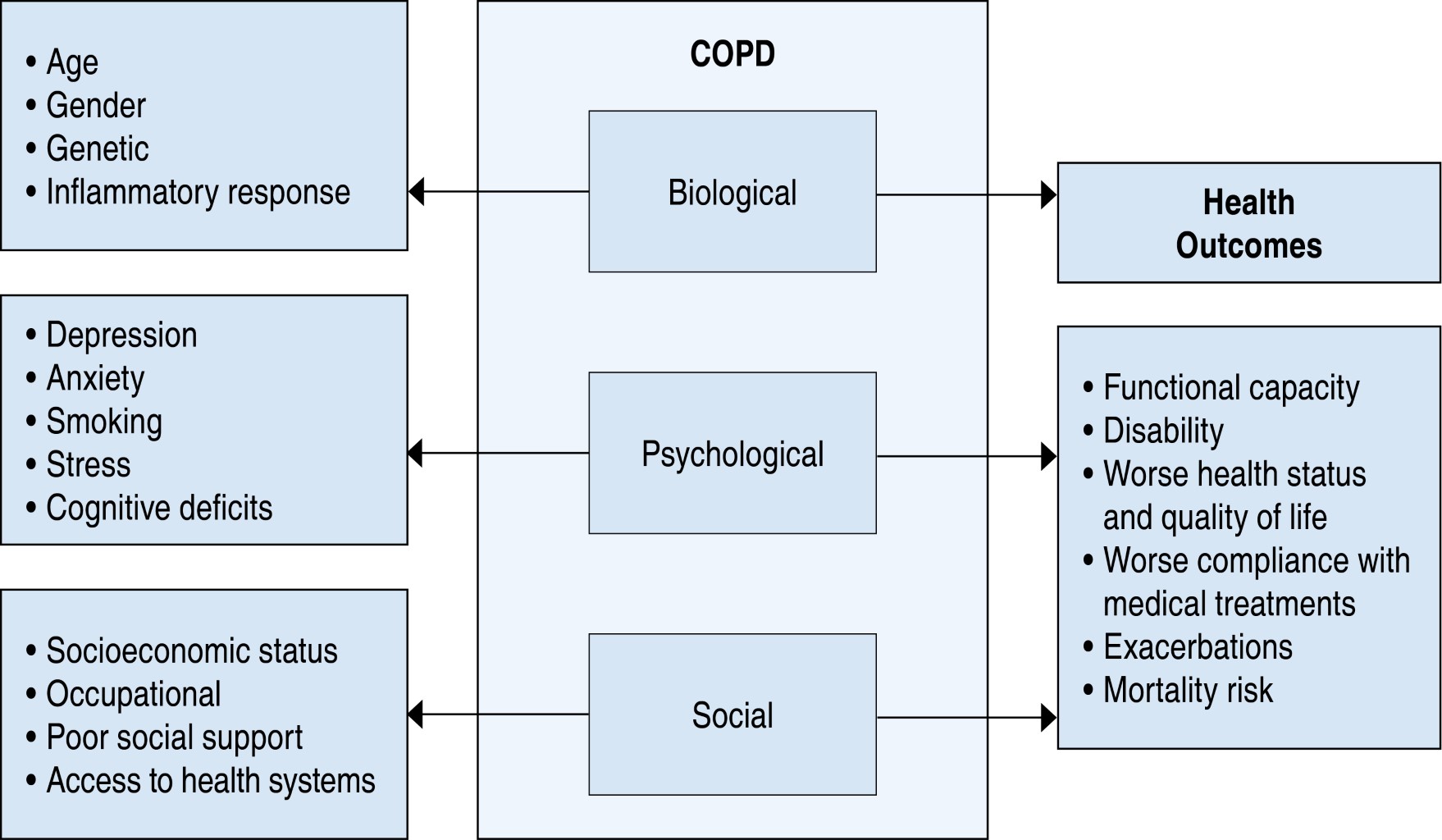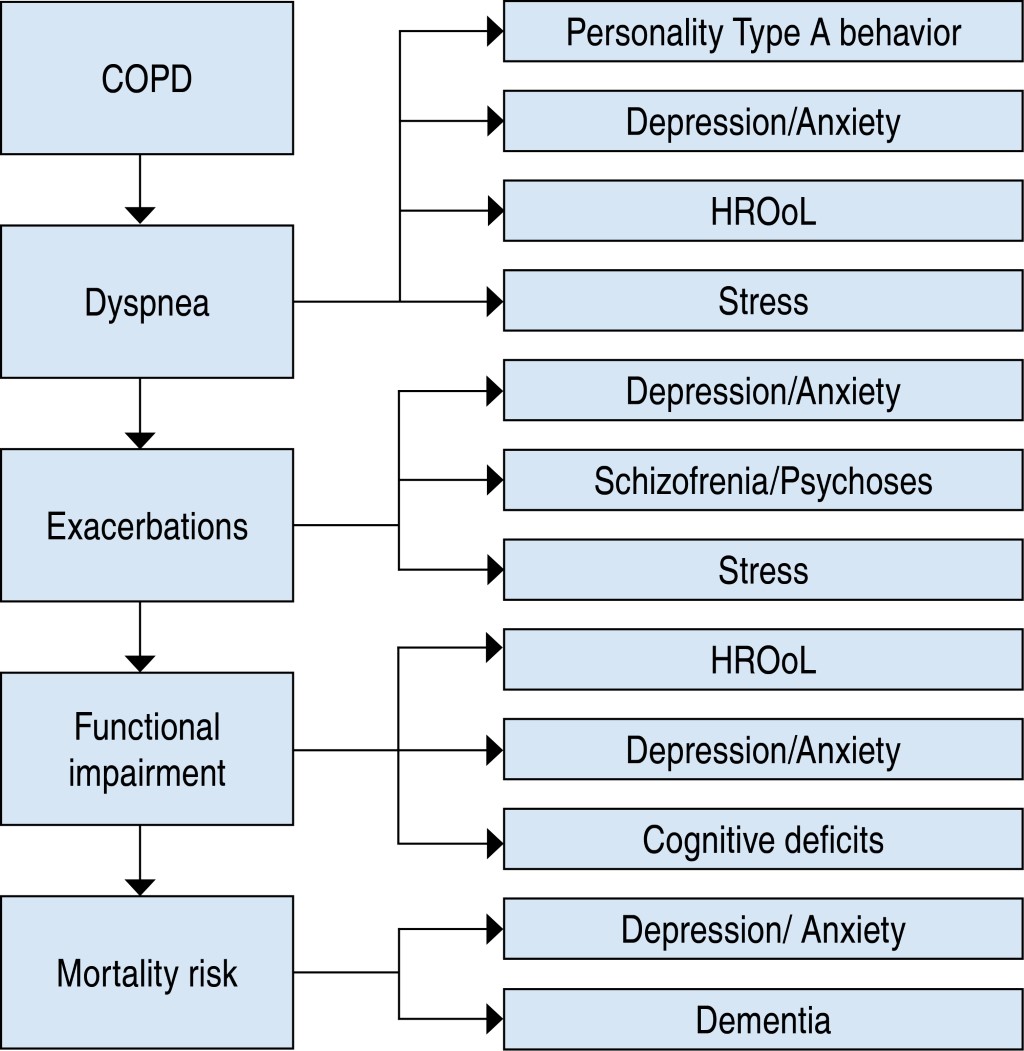Factores psicológicos asociados a la enfermedad pulmonar obstructiva crónica: una revisión narrativa
Hernández-Pérez, Andrea1,2; Vargas-Núñez, Inés2; Pérez-Padilla, Rogelio1,2; Ramírez-Venegas, Alejandra1
Hernández-Pérez, Andrea1,2; Vargas-Núñez, Inés2; Pérez-Padilla, Rogelio1,2; Ramírez-Venegas, Alejandra1
RESUMEN
La enfermedad pulmonar obstructiva crónica (EPOC) es la tercera causa principal de muerte a nivel mundial, y la carga de la enfermedad aumenta por múltiples comorbilidades, incluidos algunos trastornos psicológicos, como ansiedad y depresión, entre otros. Esta interacción entre la salud mental y la EPOC se ha convertido en un tema de intenso estudio en los últimos años. Nuestro objetivo fue describir los factores psicológicos asociados con la EPOC, la interacción de factores que conducen a un impacto en la enfermedad y analizar las alternativas de tratamiento e intervención efectivas disponibles. Se realizó una búsqueda de literatura narrativa en PubMed y Cochrane Library, utilizando una técnica de búsqueda de bola de nieve para identificar artículos publicados sobre el tema. Se realizó una búsqueda de artículos originales relevantes con énfasis en los años 2015-2021. Fue relevante el énfasis de un equipo multidisciplinario de apoyo a los pacientes con EPOC, resulta relevante la evaluación de factores psicológicos asociados a la enfermedad, especialmente ansiedad y depresión. Los tratamientos disponibles, incluidas las intervenciones psicológicas, demostraron una mejora en la calidad de vida, adherencia a los tratamientos, reducción de hospitalizaciones, sintomatología y exacerbaciones.PALABRAS CLAVE
EPOC, salud mental, ansiedad, depresión, trastorno psiquiátrico, factores de riesgo.REFERENCIAS
Witusik A, Mokros L, Kuna P, Nowakowska-Domaga?a K, Antczak A, Pietras T. Type a behavior pattern, impulsiveness, risk propensity, and empathy as predictors of dyspnea and number of infections in men with chronic obstructive pulmonary disease: a cross-sectional study. Med Sci Monit. 2018;24:3832-3839. doi: 10.12659/MSM.907742.


|
Table 1: Summary of publications regarding the association between psychological factors and pulmonary obstructive chronic disease. |
||
|
Outcome measures / Reference |
Odds ratio - risk ratio - adjusted odds ratio - hazard ratio |
Other factors found |
|
Depression and emergency hospital admissions12 Depression and attendances at emergency departments |
OR = 2.63; 95% CI (1.48-4.66)
OR = 2.78; 95% CI (1.55-4.99) |
Even mild symptoms and moderate to severe symptoms of depression increase the risk of use of urgent care, these findings are independent of severity of disease and comorbidity of other chronic physical conditions |
|
COPD and the likelihood |
OR = 1.90; 95% CI (1.27-2.48) |
Similarly, risk factors associated with suicide, such as mental disorders, are underdiagnosed and undertreated |
|
Comorbid depression and risk of mortality14 |
RR = 1.83; 95% CI (1.00-3.36). |
COPD increases the risk of developing depression (RR = 1.69; 95% CI 1.45-1.96) |
|
Bipolar disorder and COPD15 Schizophrenia and COPD16 |
OR 1.55; 95% CI (1.45-1.65) OR 1.57; 95% CI (1.43-1.72) |
The most important confounding factor the contribution of which must be evaluated to clarify the nature of the association between COPD and major mental illness is the smoking |
|
Stress with acute care use in COPD |
AOR = 2.51; 95% CI (1.06-5.98) |
The high stress group had a 2.5-fold increased adjusted odds of acute care use compared to the low stress group |
|
Physical activity-depression in COPD17 PA-anxiety in COPD |
HR = 0.85; 95% CI (0.75-0.95)
HR = 0.89; 95% CI (0.79-1.00) |
The study found more physically active patients [with higher PA levels equivalent to 2.5 metabolic equivalent tasks (METs), e.g., those who report walking outside vs. those who do not] had 15% and 11% lower risks of developing depression and anxiety, respectively, compared to physically inactive patients |
|
OR = Odds ratio, RR = risk ratio, AOR = adjusted odds ratio, HR = hazard ratio, COPD = pulmonary obstructive chronic disease, PA = physical activity, CI = confidence intervals. |
||


